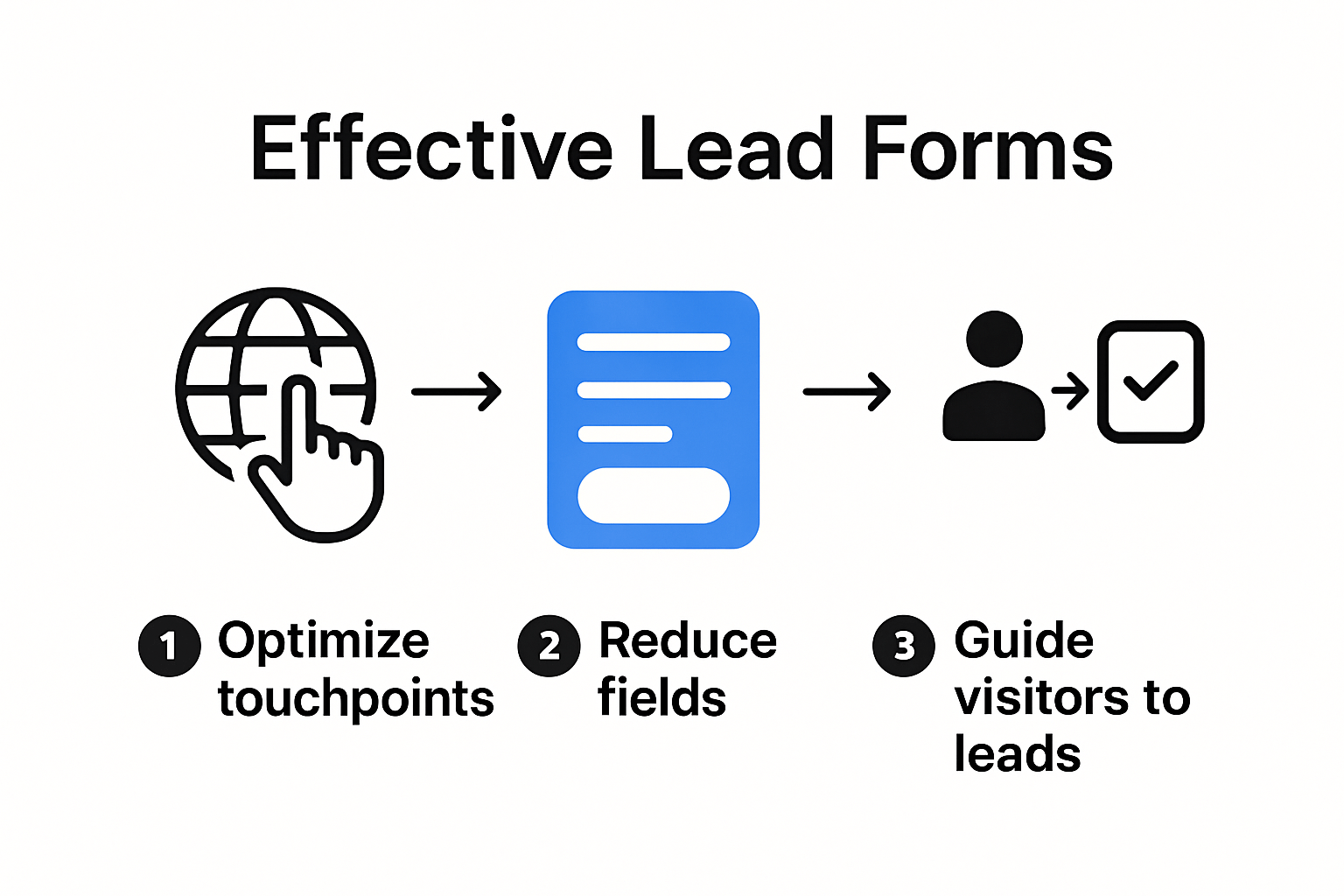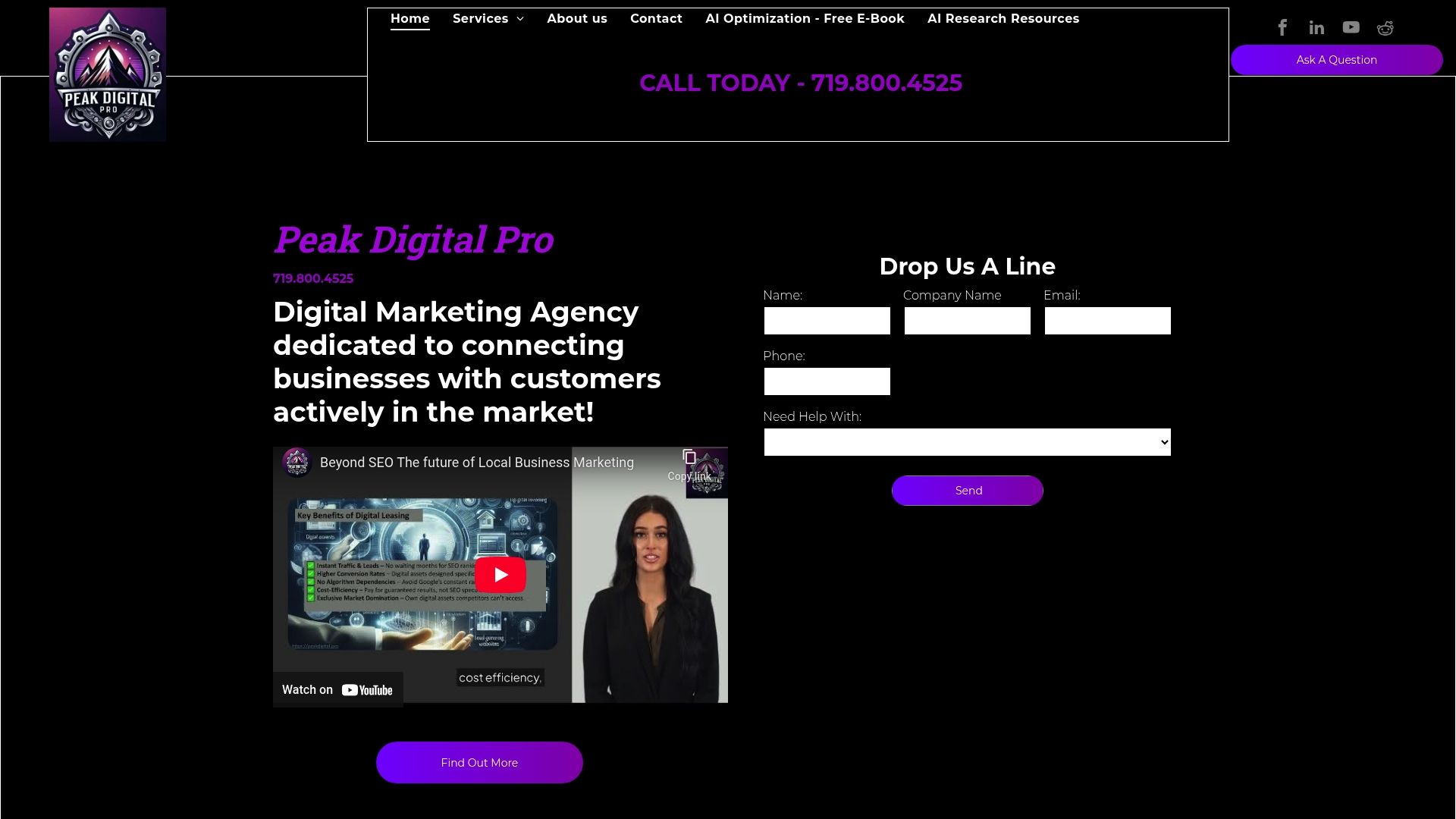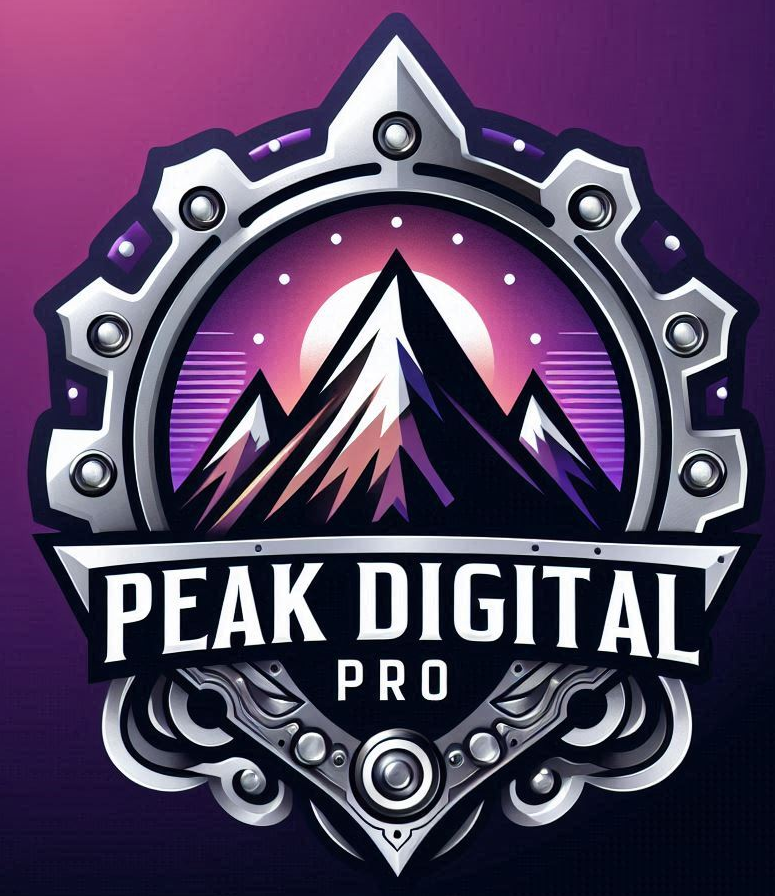Creating Lead Forms: Boost Business Growth in 2025

Lead forms can mean the difference between a visitor leaving your website and a real potential customer reaching out. Here’s something you might not expect. Simplifying your lead forms by removing just one or two questions can double your conversion rates. Most companies keep adding more fields, but the real growth hack is making things easier, not harder. Ready to see why less really is more when it comes to getting leads in 2025?
Table of Contents
Quick Summary
| Takeaway | Explanation |
|---|---|
| Simplify Lead Forms | Reducing the number of fields in lead forms can significantly boost conversion rates by making the submission process quicker and less intimidating for users. |
| Leverage Multi-Step Forms | Breaking down lead forms into multi-step processes can enhance engagement, as it reduces initial friction and creates psychological momentum encouraging users to complete the form. |
| Focus on Mobile Optimization | Ensuring that lead forms are mobile-responsive is crucial, as mobile usability can increase completion rates dramatically, making it essential for businesses to adapt to user preferences. |
| Implement A/B Testing | Regularly testing different form designs and structures can help discover the most effective practices, leading to incremental improvements in conversion rates through data-driven decisions. |
| Integrate with CRM Systems | Connecting lead forms to CRM systems allows for seamless data flow and automation of lead tracking and follow-up processes, enhancing overall efficiency and effectiveness in lead management. |
Understanding Lead Forms for Business Owners
Lead forms represent critical digital touchpoints where potential customers transform from anonymous website visitors into actionable business opportunities. These strategic interfaces serve as the gateway between initial interest and meaningful customer engagement, allowing businesses to capture essential contact information and initiate valuable relationships.

The Strategic Importance of Effective Lead Capture
Creating lead forms requires a nuanced approach that balances information gathering with user experience. Conversion optimization begins with understanding that every additional form field can potentially reduce submission rates. Marketing Experiments research demonstrates that simplifying lead generation forms by reducing the number of fields can dramatically increase conversion rates.
Businesses must recognize that modern consumers value convenience and efficiency. A form that appears complex or time-consuming can quickly discourage potential leads. This means strategically selecting only the most critical information required for initial contact. Typically, this includes fundamental details like name, email address, and perhaps a brief description of their interest or challenge.
Designing User-Friendly Lead Capture Strategies
Innovative approaches to lead form design have emerged that significantly enhance user engagement. HubSpot’s research reveals that multi-step forms can boost conversion rates by up to 86% compared to traditional single-step forms. This approach breaks down information collection into smaller, less intimidating segments, making users more likely to complete the process.
The psychology behind multi-step forms is compelling. By presenting questions progressively, businesses can:
- Reduce Initial Friction : The first step appears minimal and non-threatening
- Create Psychological Momentum : Once started, users are more likely to complete the entire process
- Provide Clearer Context : Each step can explain why specific information is being requested
To better illustrate the benefits of simplifying and optimizing lead forms, the table below summarizes the key statistical findings and their impact on conversion rates, as referenced in the article.
| Best Practice | Research Source | Reported Conversion Rate Improvement |
|---|---|---|
| Reducing Number of Fields | Marketing Experiments | Up to 2x (double) |
| Using Multi-Step Forms | HubSpot | Up to 86% increase |
| Reducing Form Fields (General UX) | Medium | Up to 50% increase |
| Mobile Optimization | Growform | Up to 50% increase |
Technological Considerations for Modern Lead Forms
Advanced lead form strategies now incorporate intelligent design principles and technological integrations. Smart forms can dynamically adjust based on user interactions, pre-filling information or offering personalized pathways. Integration with customer relationship management (CRM) systems ensures that captured lead data flows seamlessly into business workflows.
Businesses should also prioritize mobile responsiveness. With increasing smartphone usage, lead forms must function flawlessly across devices. This means creating adaptive designs that maintain usability and aesthetic appeal whether accessed on desktop, tablet, or mobile platforms.
Ultimately, successful lead forms are not just about collecting information—they’re about creating a smooth, respectful first interaction that signals your business’s professionalism and customer-centric approach. By focusing on user experience, strategic information gathering, and technological sophistication, businesses can transform lead forms from mere data collection tools into powerful customer acquisition engines.
Step-by-Step Guide to Creating Lead Forms
Designing an effective lead form requires a strategic approach that balances technical implementation with user experience. Successful lead generation depends on creating a seamless process that encourages potential customers to share their contact information willingly.
Defining Your Lead Form Objectives
Before diving into form creation, businesses must clearly articulate their specific goals. DoubleDome research emphasizes the critical importance of defining precise objectives. Are you seeking newsletter subscribers? Identifying potential sales prospects? Gathering market research data?
Your form’s purpose will directly influence its design and structure. For instance, a form targeting potential enterprise clients will differ significantly from one collecting consumer interest in a local service. This strategic alignment ensures that every question serves a meaningful purpose and provides actionable insights for your business.
Crafting an Optimal Form Structure
The art of creating lead forms involves carefully selecting questions that extract valuable information without overwhelming users. DoubleDome recommendations suggest incorporating key fields that enable effective lead segmentation:
- Contact Fundamentals : Full name, professional email address
- Business Context : Company name, industry sector
- Specific Interest : Brief dropdown or multiple-choice questions about service needs
Form design should prioritize user experience. This means minimizing the number of required fields, using clear and concise language, and providing immediate value proposition. Users are more likely to complete forms that appear quick and straightforward.
Technical Implementation and Conversion Optimization
Transforming your lead form from a concept to a functional tool requires attention to technical details and conversion strategies. Multiple-choice questions can streamline data collection, reducing user friction and increasing completion rates. A clear, compelling call-to-action button signals the next step and motivates users to submit their information.
Mobile responsiveness is no longer optional. Your lead form must adapt seamlessly across devices, ensuring a consistent experience whether accessed on desktop, tablet, or smartphone. This approach prevents potential leads from abandoning the form due to poor user interface.
Integration with customer relationship management (CRM) systems can automate lead tracking and follow-up processes. By connecting your form directly to your sales and marketing workflows, you create a smooth transition from initial contact to potential customer engagement.
Data privacy and transparency are paramount. Clearly communicate how submitted information will be used, and consider including brief privacy policy links. This builds trust and demonstrates your commitment to responsible data handling.
Successful lead forms are not static entities but dynamic tools that evolve with your business needs. Regularly analyze form performance, track conversion rates, and be prepared to make iterative improvements. A/B testing different form designs, question structures, and call-to-action statements can reveal insights that incrementally enhance your lead generation strategy.
Best Practices for High-Converting Lead Forms

Transforming lead forms from mere data collection tools into powerful conversion engines requires strategic design and psychological understanding. High-converting lead forms are not just about collecting information but creating an engaging user experience that motivates potential customers to share their contact details.
Minimizing Form Friction and Maximizing Engagement
Medium research reveals a compelling insight: reducing form fields can dramatically increase conversion rates. By strategically trimming unnecessary questions, businesses can see up to a 50% improvement in form submissions. This principle underscores the importance of creating lean, purposeful forms that respect users’ time and attention.
The key is to request only essential information. Each additional field represents a potential barrier to completion. Businesses should critically evaluate every question: Does this field provide actionable insights? Can this information be gathered later in the customer journey? By adopting a minimalist approach, lead forms become more inviting and less intimidating.
Mobile-First Design and Responsive Strategies
Growform research highlights the critical importance of mobile optimization. With mobile devices accounting for an increasing percentage of web traffic, lead forms must function flawlessly across screen sizes. Implementing mobile-friendly designs can boost completion rates by up to 50%.
Responsive design goes beyond simple resizing. It involves:
- Adaptive Input Fields : Large, touch-friendly input areas
- Simplified Navigation : Minimal scrolling and intuitive progression
- Quick Load Times : Optimized for mobile network speeds
Consider implementing smart features like auto-fill and integrated smartphone keyboard options that make form completion effortless. The goal is to eliminate any potential friction points that might discourage mobile users from submitting their information.
Continuous Optimization Through Strategic Testing
Zapier’s research emphasizes the transformative power of A/B testing in lead form design. By systematically experimenting with different form variations, businesses can uncover nuanced insights that drive higher conversion rates.
Effective A/B testing involves methodically comparing elements such as:
- Form layout and design
- Call-to-action button text and color
- Field placement and order
- Different headline variations
The table below provides a convenient checklist of best practices for creating high-converting lead forms based on the key points in this section.
| Best Practice | Benefit | Checklist |
|---|---|---|
| Minimize Number of Fields | Higher conversion rates | ✓ |
| Mobile-First & Responsive Design | More completions on all devices | ✓ |
| A/B Testing of Form Elements | Data-driven optimization | ✓ |
| Strong CTA Button | Increased user motivation | ✓ |
| Add Trust Signals/Privacy Assurance | Reduces user hesitation | ✓ |
| Use Multiple Choice Where Possible | Faster, easier completion | ✓ |
Successful lead forms are not static documents but dynamic tools that evolve through continuous refinement. Implement analytics tracking to monitor form performance, user interaction patterns, and drop-off points. This data-driven approach allows businesses to make informed design decisions that incrementally improve conversion potential.
Trust signals play a crucial role in form conversion. Include elements that build credibility, such as brief privacy assurances, security badges, or concise statements about how submitted information will be used. These small additions can significantly reduce user hesitation and increase the likelihood of form completion.
Ultimately, high-converting lead forms are a delicate balance of technical design, psychological understanding, and strategic optimization. By focusing on user experience, minimizing friction, and continuously testing and refining, businesses can transform these digital interfaces into powerful customer acquisition tools.
Top Tools and Integrations for Lead Collection
Navigating the complex landscape of lead collection requires strategic selection of tools that streamline data gathering, enhance customer insights, and integrate seamlessly with existing business systems. The right combination of technologies can transform lead generation from a manual process into an automated, intelligent workflow.
Professional Networking and Data Enrichment Tools
SuperAGI research highlights the critical role of advanced lead collection platforms. LinkedIn Sales Navigator emerges as a powerful tool, offering real-time professional network insights and customizable lead lists that integrate directly with customer relationship management (CRM) systems.
Professional data enrichment tools go beyond simple contact collection. They provide comprehensive insights into potential leads, including:
- Professional Background : Job titles, company history
- Contact Verification : Validated email addresses and phone numbers
- Behavioral Insights : Professional interests and network connections
Email Verification and Lead Qualification Platforms
Hunter.io represents a sophisticated approach to professional email discovery and verification. This platform specializes in finding and authenticating professional email addresses, offering features like Domain Search and Email Finder. Woorise’s analysis suggests these tools can dramatically improve lead quality by ensuring contact information accuracy.
Advanced platforms like Cognism take lead collection a step further. Their compliance-first approach provides international data coverage and seamless integration with popular CRM systems such as Salesforce and HubSpot. These integrations enable businesses to:
- Automatically populate contact databases
- Reduce manual data entry
- Maintain real-time information accuracy
- Ensure global data compliance standards
Strategic Integration and Workflow Automation
Successful lead collection transcends individual tools. The true power lies in creating interconnected ecosystems where data flows smoothly between platforms. Modern businesses should prioritize tools with robust API capabilities and native integrations.
Key integration considerations include:
- Compatibility with existing CRM systems
- Automated data synchronization
- Real-time lead scoring and qualification
- Compliance with data protection regulations
Implementing a comprehensive lead collection strategy requires more than just acquiring tools. It demands a holistic approach that considers:
- Data privacy and consent mechanisms
- Scalability of technological solutions
- Cost-effectiveness of integration
- Alignment with specific business objectives
Technology evolves rapidly, and lead collection tools are no exception. Businesses must remain adaptable, regularly reassessing their technological stack to ensure they leverage the most effective, efficient solutions available. By combining sophisticated tools, strategic integrations, and a data-driven approach, companies can transform lead collection from a challenging task into a streamlined, intelligent process that drives meaningful business growth.
Frequently Asked Questions
What are lead forms and why are they important for businesses?
Lead forms are digital interfaces on websites that allow potential customers to submit their contact information. They are crucial for capturing leads and converting website visitors into potential customers.
How can simplifying lead forms increase conversion rates?
Simplifying lead forms by reducing the number of fields can significantly boost conversion rates. Fewer fields can make the form appear less intimidating, encouraging more users to complete the submission.
What is the benefit of using multi-step lead forms?
Multi-step lead forms can enhance engagement and conversion rates by breaking down the process into smaller, manageable steps. This reduces initial friction and creates psychological momentum, leading to higher completion rates.
Why is mobile optimization important for lead forms?
With the increasing use of smartphones, mobile optimization ensures that lead forms function well across all devices. A responsive design can significantly increase completion rates, as many users prefer to submit forms on their mobile devices.
Ready to Convert More Leads in 2025? Take the Guesswork Out of Your Digital Growth
Is your business struggling with low form completions or overwhelmed by complex lead capture processes? The article explains how simplifying lead forms and using mobile-optimized, multi-step strategies can instantly boost conversion rates. Still, these tactics only reach their full potential when paired with a complete digital marketing approach. At Peak Digital Pro, our team understands the frustration of wasted clicks and lost opportunities. We bring proven expertise in web development, advanced SEO, and AI-powered digital strategies to transform every interaction into a high-value lead for your business.

Do not let outdated forms or disconnected marketing efforts hold you back. Tap into the tools and insights that top-performing brands use to dominate their niche. Visit Peak Digital Pro to see how our personalized solutions can help you capture more leads and build lasting customer relationships. Set your business on a path to measurable growth today with the specialists who understand what works.








